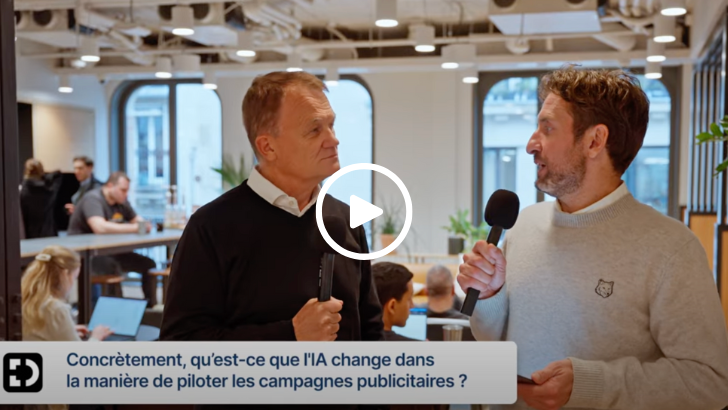.png)
Speaking to an audience of retail marketing executives, I began with a simple question:
Do you know if your digital campaigns are performing in your catchment areas?
Drawing up a digital media budget is a complex task. Between missed opportunities and overly aggressive spending, it is not always easy to reach the optimal budget for each campaign. Most traffic managers focus on performance indicators (CPM,CTR, etc.), without having a clear vision of the local performance of their ads.
However, as shown in this illustration, taken from the campaign data of one of the largest French advertisers, we can see great disparities between zones.

Optimising an advertising budget, which is what my team and I were doing at TripAdvisor, consisted of finding out which campaign was performing optimally, which was over-invested, or on the other hand, which one could be budgeted for a higher return on investment (ROI). In other words, take money out of the red campaigns and put it into the green campaigns, to find as many blue campaigns as possible.

No optimisation without segmentation...

The first step to optimisation is segmentation.
The creation of segments is a very important step, because it allows us to identify different audiences, based on demographic attributes (age, interest), the type of medium (phone, tablet, computer, etc.), or usage behaviour (heavy users, abandoners, etc.), for example.
Once the audiences have been identified, we can then start to compare the performance indicators and optimise each budget.
Historically, the most widely used segmentation has been demographic. It has led to numerous misapplications, which have resulted in the announced end of third-party cookies and the concentration of data in the hands of major players such as Meta, TikTok, Google and Amazon.
On the other hand, geographic segmentation is a powerful vector for campaign optimisation and has been at the heart of the marketing strategies of the largest advertisers for several years.
Agencies tend to use 'traditional' methods to address this new challenge, but they face many obstacles.
The limits of classical media trading to drive campaign geography
In general, campaigns are managed at the national level, media by media, and performance is analysed according to the corresponding returns on investment.
Each campaign manager indicates the areas to be targeted in the advertising networks, assuming that the display will be spread evenly over each area.
But in reality, Facebook, Google and other advertising networks will optimise the display in areas where the CTR is lowest. In the example opposite: Facebook in Grenoble.

However, marketing agency teams often have little or no coordination between media, resulting in large budgets for some cities but not others. There is no guarantee that the budget will fit the potential of each geographic area. Basically, you risk investing a lot of money in areas that don't need it, because you cannot control the geographic mix.
How can we change media trading to drive campaign geography?
-> The secret lies in a simple formula: 1 zone = 1 omnichannel campaign
Start with geo-targeting, i.e. defining each area, which in the retail world is called the catchment area. This area can consist of a series of localities, postcodes, IRIS zones, or geographical delimitations on a map (if you use DeepReach).
Each campaign will then have its own budget, media mix, ads and visuals.

The difficulty will lie in the ability to quickly launch and manage all these micro-campaigns... because instead of running a global campaign, you will have as many campaigns as you have areas.
Local adtech allows you to automate these tasks, so that the campaign ROI is not dwarfed by sleepless nights for your staff!
Compare reach and CPC in each area

Reach= the number of people you can reach
vs
CPC= how much did they pay to reach all their customers?
The relationship between the two indicators is relatively clear, as the greater the investment, the more likely we are to reach our target. Let's go into the details of 3 areas.

First example: an under-invested area
- The reach is low (reaching -15% of the potential population)
- CPC is also low but will have little impact
→ few returns

In a case of over-investment :
- The reach is high (over 50%)
- The CPC is also higher
→ This is where we are able to say that there is an inflection point.
The CPC is much too high, so we could reduce it and consequently limit expenditure in order to stabilise the reach.
Find the optimal efficiency

You can also analyse all of your zones by comparing the reach and the budget perperson (per 100 people).
In the three areas shown, it can be seen that as the reach increases, so does the budget.
In order to achieve an optimum zone, it is then necessary to withdraw budget from the red zones in order to reinvest in the green zones.
With the analysis of these geographical areas, the objective is to optimise your network and its performance thanks to this information and to obtain an optimal return on investment in order to find the budget inflection point.
Segment your network in your image

There are many ways to segment a group of zones. Other factors that can be taken into account include:
- Dense and urban areas
- Tourism: which will have a particular focus on seasonality
- Rural (with a lower density and the same cost per click, so the aim is to reach the same number of people).
Key points to remember
- Define your zones, segment your networks and launch campaigns. One per zone.
- Analyse performance for each area by comparing budget to reach and CPC
- Optimise each media independently









